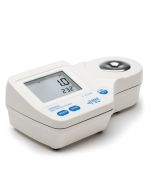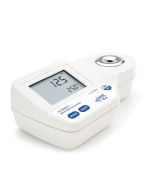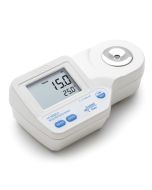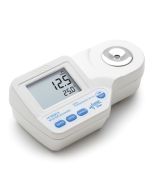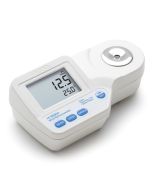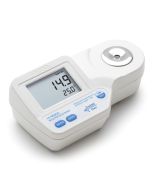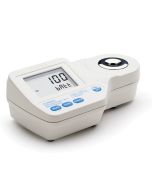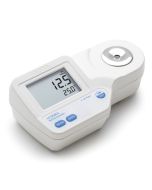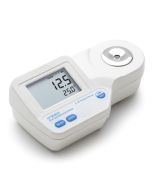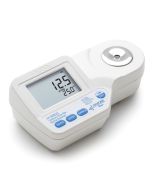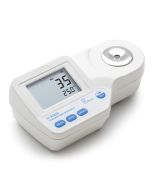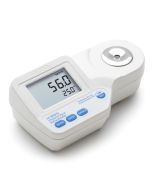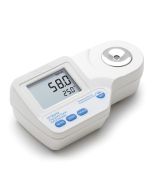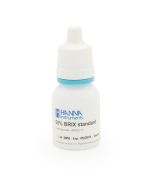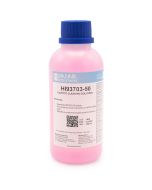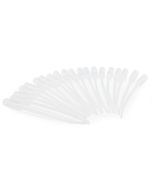Refractometry
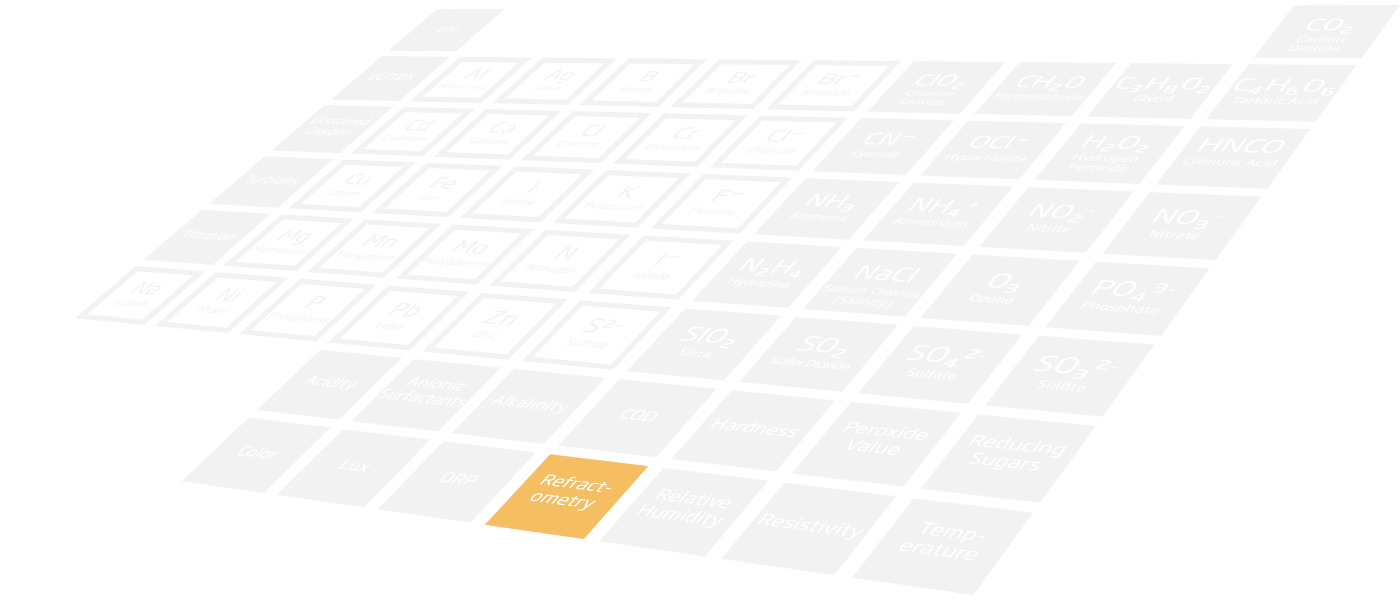
Refractive Index is an optical characteristic of a substance and the dissolved particles in it. The refractive index of a substance is strongly influenced by temperature and the wavelength of light used to measure it. Therefore, care must be taken to control or compensate for temperature differences and wavelength. The refractive index measurements are usually reported at a reference temperature of 20oC (68oF), which is considered to be room temperature.
Refractive index is defined as the ratio of the speed of light in a vacuum to the speed of light in a substance. A result of this property is that light will “bend”, or change direction when it travels through a substance with a different refractive index. This is called refraction.
When passing from a material with a higher to lower refractive index, there is a critical angle at which an incoming beam of light can no longer refract, but will instead be reflected off the interface between the two substances. This is called total internal reflection.
The critical angle can be used to easily calculate the refractive index according to the equation:
sin (Θcritical) = n2/n1
Where n2 is the refractive index of the lower-density medium; n1 is the refractive index of the higher-density medium.
A digital refractometer uses an LED to pass light through a prism in contact with the sample. An image sensor determines the critical angle at which the light is no longer refracted through the sample. Specialized algorithms then apply temperature compensation to the measurement and convert the refractive index to the specified parameter.
Hanna offers digital refractometers for the brewing, wine, food, seawater, and glycol analysis.
Brewing
The oPlato scale is a way to quantify the concentration of sugars and dissolved solids in wort. It is used as an indicator of the potential alcoholic strength of a brewing and expresses the fermentability. The refractometer converts the refractive index reading to oPlato based on the tables maintained by the International Commission for Uniform Methods of Sugar Analysis (ICUMSA) and the American Society of Brewing Chemists (ASBC).
Wine Analysis
Refractometers are available that convert the refractive index of the sample to sucrose concentration in units of percent by weight, % Brix (also referred to as °Brix).The conversion used is based on the ICUMSA Methods Book (International Commission for Uniform Methods of Sugar Analysis). Since the majority of sugar in grape juice is fructose and glucose and not sucrose, the reading is sometimes referred to as “Apparent Brix.”
Versions are also available for converting brix readings to the oBaumé, oOechsle and oKMW scales.
oBaumé scale is based on density and was originally designed to measure the mass of sodium chloride in water. oBaumé is used in winemaking to measure the sugar in must. The refractometer converts the % Brix reading to oBaumé based on the table found in the Official Methods of Analysis of AOAC International, 18th Edition. One oBaumé is approximately equal to 1.8 % Brix, and 1°Baumé is roughly equivalent to 1% alcohol when the wine is fully fermented.
oOechsle (°Oe) is mainly used in the German, Swiss and Luxenbourgish winemaking industry to measure the sugar content of must. The °Oe scale is based on specific gravity at 20oC (S.G.(20/20)) and is the first 3 digits following the decimal point. One oOe is roughly equal to 0.2 % Brix.
oOe = [(S.G.(20/20)) - 1] x 1000
oKlosterneuburger Mostwaage (oKMW) is used in Austria to measure the sugar content of must. oKMW is related to oOe by the following equation:
oOe = oKMW x [(0.022 x oKMW) + 4.54]1 oKMW is roughly equivalent to 1% Brix or 5 oOe.°KMW is also known as oBabo.
Refractometers are available that allow the winemaker to estimate the potential alcohol that will be produced from the fermentation of sugars. “Potential” or “probable” alcohol is an estimation of the alcohol content (% vol/vol). This conversion depends on many factors, such as the type of grapes, the grape maturity, the growing region and yeast fermentation efficiency and temperature.
The refractometer allows the user to tailor the instrument to their specific needs based on their experience, since no fixed conversion factor is universally applicable. The first conversion is based on the % Brix value and an adjustable conversion factor between 0.50 and 0.70 (0.55 is a common value).
Potential alcohol (% v/v) = (0.50 to 0.70) x % Brix
One drawback of the above equation is that it does not take into account the non-fermentable sugars and extract. A second equation was also added that takes these factors into account and can give a more accurate estimate of the potential alcohol content in the finished wine. This conversion is named “C1” on the meter, and uses the following equation:
Potential Alcohol (%V/V) = 0.059 x [(2.66 x oOe) - 30] (C1)
The refractometers potential alcohol curve is based on the tables found in the European Economic Community Commission Regulation No 2676/90 of September 17, 1990, Determining Community Methods for the Analysis of Wine and International Organization of Vine and Wine (OIV). The potential alcohol curve is based on the following equation:
Potential alcohol (%v/v) = g/L of Sugar / 16.83
Sugar Analysis
Hanna offers sugar refractometers to meet the requirements of the food industry. Meter options include versions that measure Refractive Index/Brix, % Brix (sucrose), fructose, glucose and invert sugar. These digital refractometers are rugged, portable, and water-resistant for measurements in the lab or field.
Sodium Chloride
Digital refractometers are available to measure sodium chloride in solutions used with food. The optical instruments employ the measurement of the refractive index to determine sodium chloride concentration in aqueous solutions.
The instrument intended for the food industry uses internationally recognized references for unit conversion and temperature compensation. It can display the measurement of NaCl concentration 4 different ways: g/100 g, g/100 mL, Specific Gravity, and °Baumé. It is not intended for seawater salinity measurements.
Seawater
A refractometer is ideal for seawater analysis and uses the measurement of the refractive index to determine the salinity of natural and artificial seawater, ocean water, or brackish intermediates. The refractive index and temperature are measured and converted into one of three popular measurement units: Practical Salinity Units (PSU), parts per thousand (ppt), or specific gravity (S.G.(20/20)). All conversion algorithms are based upon respected scientific publications using the physical properties of seawater.
Glycol
Digital refractometers are available to measure ethylene glycol and propylene glycol. These digital refractometers eliminate the uncertainty associated with mechanical refractometers. Samples are measured after a simple user calibration with distilled or deionized water. Within seconds, the refractive index and temperature are measured and converted into one of two measurement units; % volume or freezing point. The refractometers use internationally recognized references for unit conversion and temperature compensation for glycol solutions (e.g. CRC Handbook of Chemistry and Physics, 87th Edition).
Solutions
Solutions for refractometry measurement include the a Brix standard for verifying the accuracy of the refractometer. The Brix standard is supplied with a Certificate of Analysis stating the accuracy and traceability of the standard.
Accessories
Accessories include cleaning solution, microfiber cloths, and refill pipettes for transferring a sample to the well of the meter.
